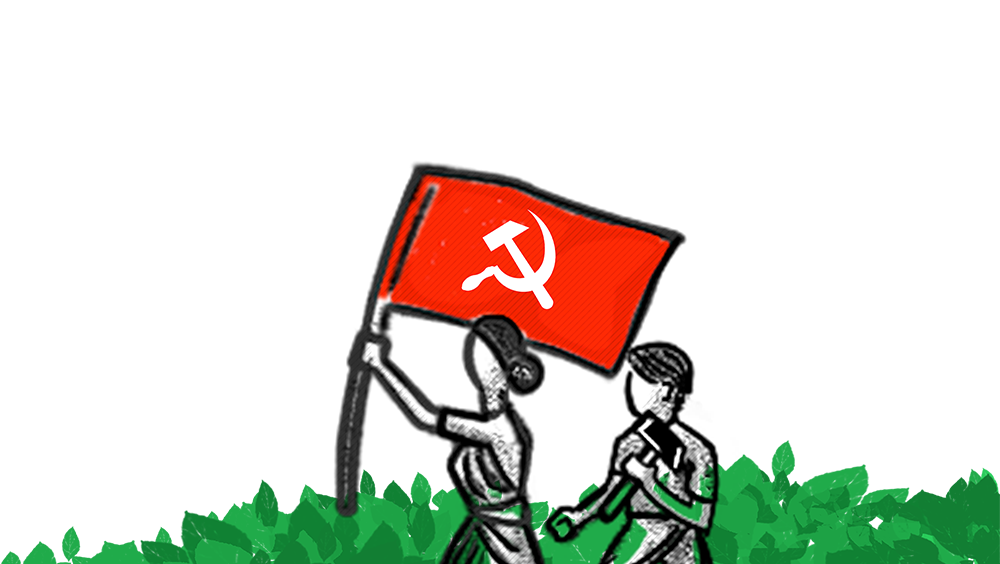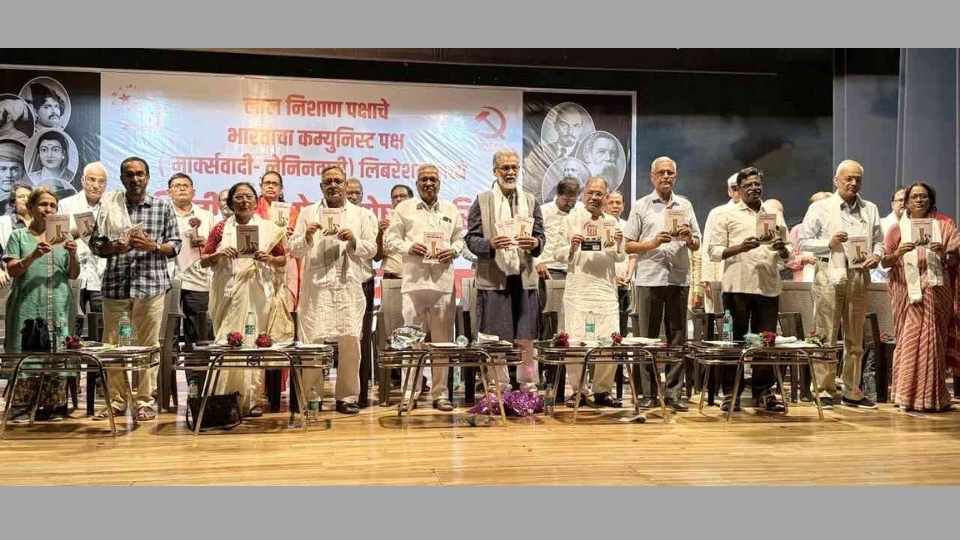[ Even though the NDA has managed to secure a narrow win in Bihar, the Bihar Assembly elections, the first major elections held in the shadow of Covid19 pandemic and the brutal, painful lockdown, have sent out very inspiring messages for all forces fighting for secure livelihood, dignity and rights of the people and the future of India as a secular democratic republic.
The Bihar elections became a veritable movement of the people and upsurge of the youth. The mandate clearly reflects Bihar's strong desire for change of government and even though the final numbers allowed the NDA to scrape through, the rise of a powerful opposition marks a big rebuff to the BJP conspiracy to render Indian democracy free of every opposition ('opposition-mukt' Bharat). On several seats which have been decided by very narrow margins, mostly in favour of the ruling NDA, there are valid concerns about irregularities or manipulation by the election authorities, efforts are being made to obtain evidence to mount a challenge as required.
The emergence of the RJD-Left-INC coalition was widely welcomed by the Bihar electorate and the CPI(ML) played a pivotal role in establishing the coalition as a viable alternative. This was vindicated by the electoral performance of our candidates - 12 victories out of 19 seats contested giving the Party the highest strike rate among the alliance constituents and an overall vote share of close to 4%. That this was achieved in the face of a vicious slander campaign against the party by senior BJP leaders is testimony to the growing support and goodwill generated by our struggles for and service to the people.
The thumping victories won by the student-youth leaders in these elections were specially satisfying as were the renewed victories won by our sitting MLAs.
The team of 12 MLAs of CPI(ML) coupled with the four victorious MLAs of the CPI(M) and CPI will serve as a powerful Left contingent within the anti-NDA opposition in Bihar Assembly. The emergence of a popular agenda centring around secure employment and quality education and healthcare for all as well as defence of farmers' and workers' rights, justice and rule of law augurs well for India's democracy, and the CPI(ML) will continue to fight hard for the implementation and advancement of this agenda.
The Bihar election campaign of the Party received valuable moral, political and financial support from comrades and friends across the country. The Central Committee extends warm greetings and heartfelt thanks to all who supported the campaign. The results of Bihar and especially the signs of electoral resurgence of the CPI(ML) and other Left parties have generated a lot of hope and enthusiasm within and beyond Bihar. While making every effort to fulfil the expectations in Bihar, the CPI(ML) Central Committee appeals to the entire Party, Left ranks and the whole range of pro-democracy forces in the country to intensify the battle against the Modi government's disastrous pro-corporate anti-people policies and the BJP's divisive hate-filled politics of communal polarisation and fascist intimidation.- ed/]
Not A Mandate For “Moditva”
In the recently concluded Bihar Assembly Elections, the ruling NDA scraped past the finish line by hook if not exactly crook. The Prime Minister, and BJP leaders, have interpreted the mandate as a vote of confidence in the PM’s handling of the Covid-19 pandemic and the lockdown. Other commentators too have taken the verdict to mean that the communal and divisive rhetoric of the PM and other BJP leaders (invoking Jai Shri Ram, Ayodhya, abrogation of Article 370, “Tukde Tukde gang”, “urban Naxal” etc) did eventually triumph. “Moditva”, it is claimed, took NDA to victory even as the Bihar CM Nitish Kumar faced anti-incumbency and anger. How accurate are these assessments?Comparing the NDA and MGB performances in 2020 with their 2015 Bihar Assembly elections performances does not give us the correct picture about the “Moditva” effect, because the composition of the NDA and MGB were different in that election. Instead, a comparison with their performance in 2010 offers more insights. In 2010, the BJP was a “pre-Modi” BJP. Such a comparison finds that JDU’s seats plummeted from 115 to 43; while BJP’s seats fell from 91 to 74. So in Bihar, the pre-Modi BJP of 2010 outperformed the Modi-fied BJP of 2020. A “single engine” JDU without the backing of an NDA regime at the Centre, a Nitish Kumar minus the Modi effect, outperformed the “double engine” JDU and Nitish Kumar of 2020. The Left parties won just one seat in 2010; in 2020 they have won 16. The NDA decline since 2010 is due not only to disillusionment with Nitish, it is also due to six years of Modi rule.
Pre-poll surveys and opinion polls generally predicted an NDA victory, and did not consider the MGB to have any chance. In the 2019 General Elections, the RJD had a lead in just nine Assembly constituencies, the Congress in five and the CPIML in one. Few had any doubts that the NDA would easily be able to prevail over an RJD-Congress-Left alliance.
Youth, Contract Teachers, Migrants, Women Backed Mahagathbandhan
There is no doubt, then, that the opposition alliance confounded the pundits to emerge as a credible and popular force that lost the elections only by a wafer thin margin. Moreover, the Magathbandhan performed the feat of firmly establishing permanent government jobs, equal pay for equal work, workers’ rights, migrant workers’ rights, as well as education and health as the foremost agenda for the elections.
The impact of the ‘equal pay for equal work’ promise made by the MGB can be seen in the fact that the MGB candidates got the lion’s share of postal ballot votes: reflecting the enthusiastic support of the state’s teachers who were on polling duty. Is it true that pain the humiliation meted out to migrant workers by the Modi regime at the centre and the Nitish Kumar Government in Bihar, made no difference to migrant workers’ loyalty to the BJP and NDA? The Lokniti-CSDS survey found “that the NDA did far worse among migrant households than among nonmigrants. Around four of every 10 households said they had a member/s living outside Bihar and among voters from such households, the NDA secured around four percentage points less votes as compared to non-migrant households.” (‘Decoding the close Bihar election 2020 verdict’, Indian Express, November 19, 2020).
The claim of women voters being the key factor in the NDA victory does not really hold up to closer scrutiny, either. Shashi Shankar Singh, a close observer of the Bihar elections, noted in a Twitter thread that the 10 seats on which women polled lowest in comparison to men, were seats that the BJP won by a handsome margin. Women voters came out to vote most on seats in Seemanchal, Tirhut, Kosi and Mithilanchal, where they voted overwhelmingly for RJD, Congress, AIMIM and CPIML. These are seats where male voters too favoured these parties. MGB parties as well as the NDA’s BJP and JDU have won seats where women voters outnumbered men – and also seats where male voters outnumbered women. There is little correlation between a higher turnout of women, and an NDA victory.
Voters Rejected BJP’s Attacks On CPIML
The Bihar elections this year do not testify to the irresistibility and unstoppability of BJP’s communal dog whistles and its campaign to brand its opponents anti-national. The most persuasive example of this fact, is the performance of the CPIML, the strike rate of which by all accounts was impressive. This is especially significant when one recalls that the election speeches of BJP’s star campaigners, including PM Modi, President JP Nadda and UP CM Adityanath, as well as the BJP’s media and social media campaign attacked the CPIML even on seats where it was not in the contest. To target the CPIML, the BJP used all the rhetoric we are familiar with from the hatemongering TV anchors and shows. They called the CPIML “urban Naxal” and “Tukde Tukde gang”, they charged CPIML with being “terrorist” because of its history of anti-feudal struggles, and “anti-national” because it stood with Kashmir against the abrogation of Article 370, and with the Shaheen Bagh movement against the CAA. What is remarkable is how these attacks were powerless to affect the CPIML’s performance and its appeal amongst voters. Ana analysis by Scroll. in found that the CPIML “performed as well as the Rashtriya Janata Dal and even outperformed it across four subregions”, concluding that this “indicates the presence of an actual resurgence of the Left, and not just an effect of alliance politics.”
What we need to take away from the Bihar elections is not the myth of a tefloncoated Moditva that thrives in spite of its many sins by invoking Islamophobia and hate. It is the message for India’s Opposition that carries both hope and a challenge: indicating that consistent grassroots work that stands with people in their struggles, and recognises and boldly resists injustice, can in fact diminish the power of hate and bigotry.
A CPIML Resurgence Buoyed Up The Grand Alliance
In the recently concluded Bihar Assembly Elections, the Left parties won 16 out of the 29 seats allocated to them; and the CPIML (Liberation) won 12 out of the 19 seats it contested. Even while NDA has scraped through, it is undeniable that Bihar has elected an inspiring Opposition, with a strong Left contingent at its core.
It is worth noting that an analysis in Scroll. in (‘Decoding the Bihar results in 32 charts: Turnouts, vote shares, victory margins and more’, November 15, 2020) found that “the CPIML performed as well as the Rashtriya Janata Dal and even outperformed it across four subregions,” indicating “an actual resurgence of the Left, and not just an effect of alliance politics.”
Moreover, the CPIML’s performance buoyed up the entire Mahagathbandhan in its areas of influence. The Scroll analysis found that “in the southern regions, where the Mahagatbandhan swept, both the BJP and to a larger extent the JDU were badly defeated by various Mahagatbandhan candidates….Census data reveals that there is a greater Dalit population in the Bhojpur area. The Mahagatbandhan did particularly well in reserved seats this election.” While Bhojpur does have a significantly large Dalit population, it also has a fairly recent history of extreme feudal oppression. Over three decades of anti-feudal assertion led by the CPIML in Bhojpur and southern Bihar, has counted towards MGB wins in this region.
No Shortcuts: Only Basic ABCs
For the past some years, mainstream media discourse has been full of schadenfreude about the decline of Left politics in India. Even acknowledgements of the popularity of young student leaders on the Left, have been used to drive this discourse, pitting the young leaders as “charismatic individuals” against supposedly outdated Left parties. The CPIML’s Bihar performance has, once again, proved that such “reports of the demise of the Left in India are greatly exaggerated.”
In the wake of the Bihar results, many have asked us what shiny, new, smart “Chanakya-niti” did the CPIML use in Bihar? The answer may sound disappointing. CPIML has no “secret sauce” or shortcut to offer. Its success now comes on the back of many cruel defeats and losses. CPIML’s work is all about the ABCs of the Left. But perhaps those ABCs do need restating with emphasis now. In that spirit, I would like to outline some key features of the CPIML’s work in Bihar.
Struggles For Social and Political Justice
Right from its early days in the 1980s, the CPIML in Bihar acted on the firm MarxistLeninist understanding that “class struggle” did not operate in an imaginary realm of “pure economic struggles.” Instead, struggles for social and political justice were recognised as being as integral to class struggle as those for economic justice. So, the ML movement in southern Bihar asserted the right to land and wages; the right for the oppressed communities to occupy public space as equals deserving of dignity; and the right for the oppressed to cast votes and even elect leaders.
The struggle for voting rights of Dalits and EBCs in Bihar, a struggle of which the CPIML was the driving force, is comparable in its historical significance to the Civil Rights movement of the USA which fought for African Americans to avail their right to vote. For a movement with that history, it is not difficult to see the NRC-NPR-CAA as a “voter suppression” move to snatch away hard-won voter rights; a move to disenfranchise not only the Muslims but entire oppressed labouring communities.
Some wonder how the CPIML alliance with RJD could work so well, given the sharp contention between the two parties the nineties and early noughties. The CPIML, unlike the CPI and CPIM, did not ally with the RJD when it was in power. Perhaps in large part as a result of this decision, the CPIML retained its independent mass base and political profile, even as the CPI declined rapidly during the same period. But even during that period, the CPIML did not let up in its ideological and political work against the RSS and BJP. The CPIML mass base and rank and file now has no trouble recognising the dangers posed to democracy by the BJP in Bihar and India: and so an alliance with the RJD has been embraced as necessary and welcome.
Third, the CPIML is bold rather than shame-faced and furtive about taking up issues of political injustice. When Yogi was telling BJP election rallies the CPIML was “anti-national”, and thanks to the BJP, the people of Bihar can buy land in Kashmir, the CPIML reminded Bihar’s poor and deprived that what they needed was homestead land in Bihar – and it was the NDA regime that violently evicted them from such land in order to appease big landlords and corporations. Kapil Mishra and Anurag Thakur, the hatemongers responsible for the Delhi massacre of Muslims, campaigned in Bihar branding the CPIML as a “break India gang” for supporting Shaheen Baghs. The CPIML, meanwhile, did not hesitate to remind everyone to vote to defend the Shaheen Baghs which are the most inspiring civil rights and equal citizenship movement of our time. Every CPIML campaign speech urged people to ensure that no Umar Khalid, Sudha Bharadwaj, Anand Teltumbde or Stan Swamy was wrongfully jailed in Bihar.
It is not necessary, or even possible, to replicate the Bihar alliance model in every state where elections are due. The takeaways from the Bihar experience are: that an ideological and political resistance to the BJP’s expansion must be the top priority; that strengthening the Left movement is crucial to building a stronger bulwark against fascist politics; and that the Opposition as a whole needs to build grassroots agitations on issues of livelihood, jobs, education, and health, as well as against all instances of social and political discrimination and injustice.





